Technical Newsletter
Issue 35
Sound Abatement Achieved on a Busy Highway
When Highway 212 was expanded, the road increased traffic volume to SW Mpls. With such expansions, it is common that housing and/or commercial developments follow close. Lennar Homes was one of the developments that looked at the area and finalized a new housing development - Reflections at Lake Riley. Upon review of the site, it was apparent that the traffic on the multi-lane highway added a large amount of unwanted noise for the newly constructed homes. Lennar worked with a local certified Allan Block contractor, Designing Nature Inc, out of Hamel, Minnesota to come up with a solution for the site. Designing Nature hadn’t worked with AB Fence yet, but since they were comfortable with other Allan Block products, they began researching and found that this scenario was perfect for using AB Fence. After reviewing the products, Lennar established that AB Fence would meet the criteria for sound and the color would be neutral for the location.
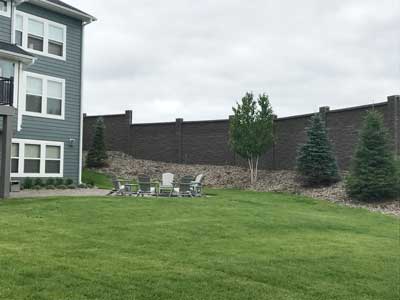
Now that Lennar had selected a product and the site layout was established, it was up to Designing Nature to begin the construction of the sound wall. Even as a new system to the contractor, the step by step installation and the assistance of Amcon Concrete Products, the local Allan Block producer, helped streamline the installation process. Designing Nature used an unreinforced concrete leveling pad between the piles to save on leveling the base block. Although the material cost was higher, they were able to increase efficiency and save on installation time.
Once the piles and base were completed, the fence was built in no time at all. Before long, over 4,200 ft2 (400 m2) of fence was installed which met all the requirements of Lennar Homes. Lennar found that the fence system worked so well that they decided to establish a second development a few miles down the road. With the second fence, Lennar specified AB Fence this time around based on the perfect fit at the previous development. Since Designing Nature now had the experience with AB Fence, they were able to competitively bid the project and were awarded the AB Fence construction for the development at Camden Ridge.
The project wasn’t anything out of the ordinary. Lennar specified an 8 ft high sound wall (2.4 m) which was to be placed on a berm to reduce the noise level of Highway 212 close by. Designing Natured hired Duffy Engineering, the local Engineer of Record to provide the full calculations.
The initial layout of the fence system is the most important part of the project. Taking the extra time to verify exact pile locations will save a lot of time during the building of the fence. Designing Nature did just this by using the installation guide from Allan Block and the jig construction which kept the fence spaced properly. Before Lennar could blink an eye, Designing Nature had constructed the full 8 ft (2.4 m) sound wall which spanned more than 830 ft long (250 m)!
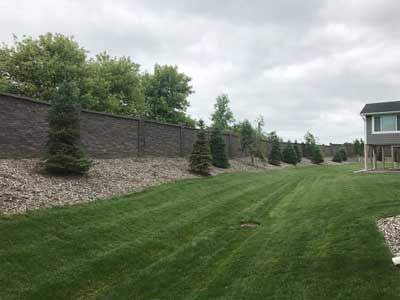
Soon after the fence was installed, Lennar had acoustical testing done which resulted in a noise level exceeding what was originally thought. It was found that the fence would need to be 10 ft high (3 m) to interrupt the noise from Highway 212. Lennar went back to Designing Nature and Duffy Engineering to check calculations on the fence and a possible solution. After reviewing the calculations, the design had enough capacity to increase the height of the fence as the original foundation design had to be increased in depth due to the position on the berm. This allowed the additional 2.6 ft (0.8 m) to be transferred to the foundation without requiring a redesign of the piers. With the solution found, the construction soon followed. The increased height required the posts to be dowelled in to provide reinforcement from bottom to top. Designing Nature was required to embed the new rebar into the existing post while providing reinforcement for the additional height of the fence. An additional bond beam was required per the calculations which was placed in the top two courses of the added height. The fence was then recapped which brought the fence to the required design height and gave Lennar the decibel reduction that they were looking for.
Both projects were brought together by the site contractor, sub-contractor, engineer, and client working as a team to establish the best option moving forward. AB Fence met all requirements and has the versatility to adapt with site changes even after the initial construction was completed.
Sound Barrier Considerations
Sound
There are several reasons why an AB Fence is constructed. The projects in the intial story showed one project was primarily used for aesthetic reasons while the other was to provide a sound barrier. With the AB Fence you get both, but there are things that need to be considered when creating a sound barrier.
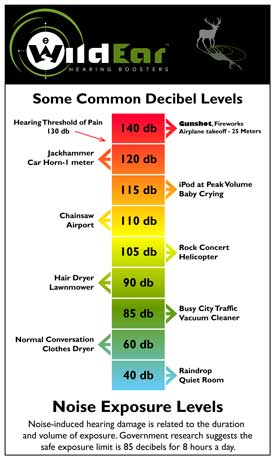
Starting with the basics, sound is the actual vibration that spreads as a typical mechanical wave of pressure and displacement through air, water or other material. Sound becomes relevant when the waves are perceptible to human ears. Obviously, some animals have different hearing ranges which is why dogs, for instance, can perceive waves higher than we can.
When it comes to sound, most people are concerned with how loud it is. The decibel (dB) is commonly used in acoustics as a unit of sound pressure level. The reference pressure for sound in air is set at the typical threshold of perception of an average human. The figure to the right provides common comparisons used to illustrate different levels of sound pressure. The human ear has a large dynamic range in sound reception. Such large measurement ranges are conveniently expressed in logarithmic scale.
The dB sound pressure levels are unweighted. The dBA levels are "A" weighted according to the weighting curves to approximate the way the human ear hears.
Noise
Noise is typically defined as unwanted sound. So, roadway noise is the collection of sound that is produced by motor vehicles. When the Noise Pollution and Abatement Act, commonly referred to as the Noise Control Act (NCA), was passed in 1972 things rapidly changed putting noise pollution front and center in the public eye. This legislation requires all federally funded major actions to be analyzed for all physical environmental impacts including noise pollution. It also set the framework for maximum permissible sound levels which vary greatly depending on the site:
- It may define different levels based on zoning requirements, such as residential, commercial, or industrial.
- It may define different maximum levels based on the time-of-day or day-of-week. This is very common since the intention is to reduce levels during the evenings or weekends when people are home.
- It may require measurement of the frequency spectrum, such as A-weighting, dB(A).
- It may require the measurement method to be instantaneous, such as dB(A) or time-averaged, such as Energy Equivalent Level (Leq).
- It may be a fixed level limit, such as 55 dB(A), or it may be a level relative to the ambient sound such as 5 dB(A) above ambient sound.
Roadway noise consists mainly of roadway surface, tire, engine/transmission, aerodynamic and braking elements. However, most agree that tire pavement noise is the biggest contributor to roadway noise. Here are three things to consider when looking at potential roadway noise problems:
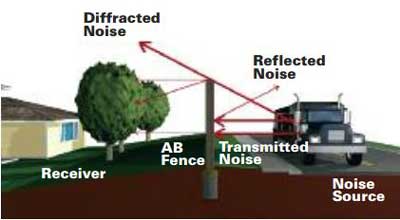
- Traffic Operation – Vehicle speed will significantly impact the sound generated since the sound energy roughly doubles for each increment of 10 miles an hour (16 km/hr) in vehicle speed. The only exception to this is at lower speeds where acceleration and braking noise may dominate.
- Roadway Surface – In most cities the common types of surfaces may vary the sound level by 4 dB. Chip seal and grooved roads are the loudest while smooth concrete are the quietest. Typically, an asphalt surface will be average.
- Roadway geometries and surrounding terrain – These are interrelated since the sound propagation is so sensitive to the overall geometry of the site. One must consider diffraction (bending of sound waves around an obstruction), reflection and transmission loss through a barrier.
The roadway geometries and terrain are the reasons why the AB Fence had to be heightened another 4 ft (1.2 m) with the Lennar project. In the 4th Quarter AB Tech Nwltr of 2012, the Federal Highway Administration’s (FHWA) article of Keeping the Noise Down was referenced and it talked about two rules-of-thumb that are good to revisit here:
- Generally, a noise barrier can achieve a 5 dB noise level reduction when the line-of-sight is broken from the source to the receiver. A rule-of-thumb is that after the line-of-sight is broken a barrier may reduce the noise level by another 1.5 dB for each 3.2 ft (1 m) in the height of the barrier.
- The other rule of thumb provided was making sure the length of the fence be at least eight times as long as the distance from the receiver to the barrier to minimize the sound coming around the ends of the fence.
Sound Defined
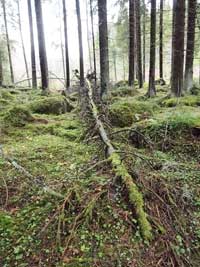
If a tree falls in the forest with no one around to hear it fall, does it make a sound?
This question has been debated over the years and it depends on how sound is defined. In 1947, the Webster’s Dictionary defined sound as that which is heard. Therefore, the answer to the question would have been “no”. However, it is now understood that sound is a physical vibration that propagates as a mechanical wave of pressure. Therefore, a tree will make sound even if nobody is around.
Plan Your Fence Layout

Allan Block has tools available to makes it easy to draw your fence panels. The AutoCAD Fence Macro allows you to configure your panels to fit any project requirements. It helps lay out multiple panels, detailed panel drawings, panel sections, and post sections. Download the Allan Block Fence Macro for AutoCAD to quickly lay out standard pattern and Ashlar pattern fence designs.



